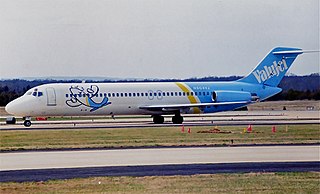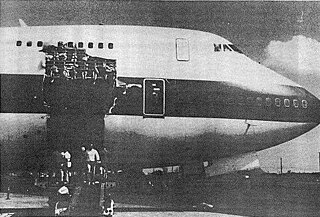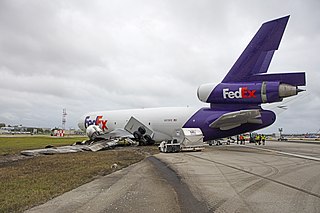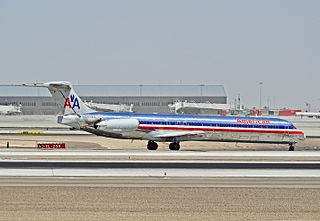
The McDonnell Douglas DC-10 is an American trijet wide-body aircraft manufactured by McDonnell Douglas. The DC-10 was intended to succeed the DC-8 for long-range flights. It first flew on August 29, 1970; it was introduced on August 5, 1971, by American Airlines.

ValuJet Airlines Flight 592 was a regularly scheduled flight from Miami to Atlanta. On May 11, 1996, the ValuJet Airlines McDonnell Douglas DC-9 operating the route crashed into the Everglades about 10 minutes after departing Miami as a result of a fire in the cargo compartment possibly caused by mislabeled and improperly stored hazardous cargo. All 110 people on board were killed. The airline already had a poor safety record before the crash, and the accident brought widespread attention to the airline's problems. ValuJet's fleet was grounded for several months after the accident. When operations resumed, the airline was unable to attract as many customers as it had before the accident. It acquired AirTran Airways in 1997, but the lingering damage to the ValuJet name led its executives to assume the AirTran name. It is the deadliest plane crash in Florida as of 2024.

Saudia Flight 163 was a scheduled Saudia passenger flight departing from Quaid-E-Azam Airport in Karachi, Pakistan, bound for Kandara Airport in Jeddah, Saudi Arabia, via Riyadh International Airport in Riyadh, Saudi Arabia, which caught fire after takeoff from Riyadh International Airport on 19 August 1980. Although the Lockheed L-1011-200 TriStar made a successful emergency landing at Riyadh, the flight crew failed to perform an emergency evacuation of the airplane, leading to the deaths of all 287 passengers and 14 crew on board the aircraft from smoke inhalation.

Air Canada Flight 797 was an international passenger flight operating from Dallas/Fort Worth International Airport to Montréal–Dorval International Airport, with an intermediate stop at Toronto Pearson International Airport.

On the evening of February 1, 1991, USAir Flight 1493, a Boeing 737-300, collided with SkyWest Airlines Flight 5569, a Fairchild Swearingen Metroliner turboprop aircraft, upon landing at Los Angeles International Airport (LAX). As Flight 1493 was on final approach, the local controller was distracted, though air traffic was not heavy at LAX, by a series of abnormalities, including a misplaced flight progress strip and an aircraft that had inadvertently switched off the tower frequency. The SkyWest flight was told to taxi into takeoff position, while the USAir flight was landing on the same runway.

American Airlines Flight 96 (AA96/AAL96) was a regular domestic flight operated by American Airlines from Los Angeles to New York via Detroit and Buffalo. On June 12, 1972, the left rear cargo door of the McDonnell Douglas DC-10-10 operating the flight blew open and broke off en route between Detroit and Buffalo above Windsor, Ontario; the accident is thus sometimes referred to as the Windsor incident, although according to the NTSB it is an accident, not an incident.

United Airlines Flight 811 was a regularly scheduled airline flight from Los Angeles to Sydney, with intermediate stops at Honolulu and Auckland. On February 24, 1989, the Boeing 747-122 serving the flight experienced a cargo-door failure in flight shortly after leaving Honolulu. The resulting explosive decompression blew out several rows of seats, killing nine passengers. The aircraft returned to Honolulu and landed without further incident.

Southern Airways Flight 242 was a flight from Muscle Shoals, Alabama, to Atlanta, Georgia, with a stop in Huntsville, Alabama. On April 4, 1977, it executed a forced landing on Georgia State Route 381 in New Hope, Paulding County, Georgia, United States, after suffering hail damage and losing thrust on both engines in a severe thunderstorm.

National Airlines Flight 27 was a scheduled passenger flight between Miami, Florida, and San Francisco, California, with intermediate stops at New Orleans, Louisiana; Houston, Texas; and Las Vegas, Nevada, United States.

The 1994 St. Louis Airport collision occurred when TWA Flight 427, operated using a McDonnell Douglas MD-82, struck a Cessna 441 Conquest II during its take-off roll, killing both of its occupants. The incident took place on November 22, 1994, at St. Louis Lambert International Airport (STL) in Bridgeton, Missouri.

The 1990 Wayne County Airport runway collision involved the collision of two Northwest Airlines jetliners at Detroit Metropolitan Wayne County Airport on December 3, 1990. Flight 1482, a scheduled Douglas DC-9-14 operating from Detroit to Pittsburgh International Airport, taxied by mistake onto an active runway in dense fog and was hit by a departing Boeing 727 operating as Flight 299 to Memphis International Airport. One member of the crew and seven passengers of the DC-9 were killed.

Southwest Airlines Flight 2294 (WN2294/SWA2294) was a scheduled US passenger aircraft flight which suffered a rapid depressurization of the passenger cabin on July 13, 2009. The aircraft made an emergency landing at Yeager Airport in Charleston, West Virginia, with no fatalities or major injuries to passengers and crew. An NTSB investigation found that the incident was caused by a failure in the fuselage skin due to metal fatigue.

Allegheny Airlines Flight 485 was a regularly scheduled domestic passenger flight between Washington, D.C. and Newport News, Virginia, United States, with three stop-overs, two in Connecticut and a third in Pennsylvania. On June 7, 1971, the Allegheny Airlines Convair CV-580 operating the flight crashed on approach to Tweed New Haven Regional Airport, New Haven County, Connecticut.

UPS Airlines Flight 6 was a cargo flight operated by UPS Airlines. On September 3, 2010, the Boeing 747-400F flying the route between Dubai, United Arab Emirates, and Cologne, Germany, developed an in-flight fire, which caused the aircraft to crash, killing both crew members, the only people on board. It was the first fatal air crash for UPS Airlines. The crash prompted a re-evaluation of safety procedures protecting airliners from cockpit smoke.

On December 20, 1972, North Central Airlines Flight 575 and Delta Air Lines Flight 954 collided on a runway at O'Hare International Airport in Chicago, Illinois, in the United States. Ten people died – all on the North Central aircraft – and 17 were injured in the accident. This was the second major airliner accident to happen in Chicago in December 1972; the other was United Airlines Flight 553, which crashed twelve days earlier on approach to Midway Airport.

Aeroflot Flight 2306 was a scheduled domestic passenger flight from Vorkuta to Moscow in the Soviet Union, with a stopover in Syktyvkar. The Tupolev Tu-134 operated by Aeroflot crashed on 2 July 1986 during an emergency landing after it departed Syktyvkar, killing 54 of 92 passengers and crew on board.

On October 28, 2016, FedEx Express Flight 910, a McDonnell Douglas MD-10-10F flying from Memphis International Airport to Fort Lauderdale–Hollywood International Airport was involved in a runway skid after a landing gear collapse, which resulted in a fire completely destroying the left engine and wing. Two crew members, the only people on board, were unharmed.

American Airlines Flight 132 was a regularly scheduled flight from Dallas Fort Worth International Airport to Nashville International Airport. On February 3, 1988, the McDonnell Douglas MD-83 operating this route experienced an in-flight fire shortly before landing at Nashville International Airport in Nashville, Tennessee. There were no fatalities, but later investigations revealed that improperly stored hazardous materials caused a hydrogen peroxide reaction in the cargo hold that leaked and combined with a sodium orthosilicate based mixture in a container which was also improperly stored. As a result, regulations to prevent future incidents were adopted by the FAA, although these were not fully implemented until after the crash of ValuJet Flight 592 in 1996.





















